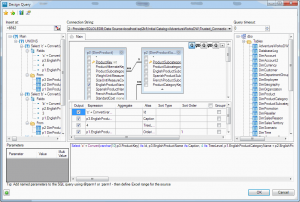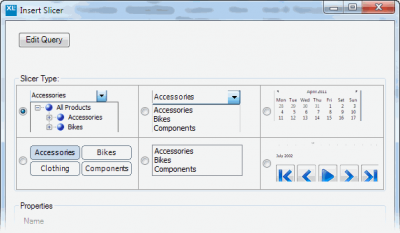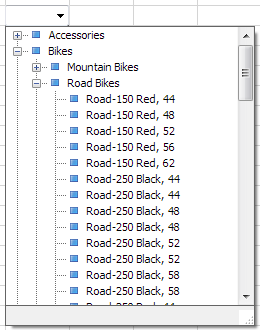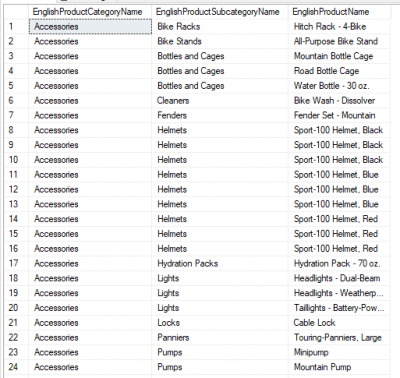| XLCubed is now FluenceXL. The new wiki can be found here: https://help.fluencexl.com/ |
Difference between revisions of "Constructing a Tree Slicer For SQL"
(Created page with "As for Excel Range Slicers, SQL Slicers can also allow users to select items in a familiar tree style. The key is to have three columns re...") |
(→Example result sets for different query styles) |
||
| (6 intermediate revisions by the same user not shown) | |||
| Line 1: | Line 1: | ||
| − | As for [[Excel Range Slicers]], [[SQL Slicers (Administrators)|SQL Slicers]] can also allow users to select items in a familiar tree style. The key is to have three columns returned by the SQL query: | + | As for [[Excel Range Slicers]], [[SQL Slicers (Administrators)|SQL Slicers]] can also allow users to select items in a familiar tree style. |
| + | |||
| + | There are 4 different query layouts you can choose from depending on your database schema. In each case the result set must be in the order you wish to display the resulting tree. The modes are: | ||
| + | |||
| + | * Depth column | ||
| + | ** Result set has 3 columns for key, description and depth of the node. | ||
| + | * Parent column | ||
| + | ** Result set has 3 columns for key, description and parent key | ||
| + | ** Key and Parent key must not be null, you can use -1 for top level nodes | ||
| + | * One column per level | ||
| + | ** Each column is a level in the tree. High level node values are repeated on each row | ||
| + | * Key and Caption per level | ||
| + | ** Each key and caption column pair is a level in the tree. High level node values are repeated on each row. | ||
| + | |||
| + | ==Example== | ||
| + | In this example, we will use Microsoft's Adventure Works demo relational database, and the DimProduct, DimProductSubcategory and DimProductCategory tables, which will be familiar to users of the Adventure Works cube as the Product dimension sources. | ||
| + | |||
| + | This uses the Depth column query style. The key is to have three columns returned by the SQL query: | ||
# ID column | # ID column | ||
# Caption column | # Caption column | ||
| Line 5: | Line 22: | ||
Any additional columns will be ignored. | Any additional columns will be ignored. | ||
| − | |||
| − | |||
| − | |||
<ol> | <ol> | ||
| Line 17: | Line 31: | ||
'c' + CONVERT(varchar(10), p3.ProductKey) AS Id | 'c' + CONVERT(varchar(10), p3.ProductKey) AS Id | ||
, p3.EnglishProductName AS Caption | , p3.EnglishProductName AS Caption | ||
| − | , | + | , 3 AS TreeLevel |
, p1.EnglishProductCategoryName + p2.EnglishProductSubcategoryName + p3.EnglishProductName AS Ordering | , p1.EnglishProductCategoryName + p2.EnglishProductSubcategoryName + p3.EnglishProductName AS Ordering | ||
FROM dbo.DimProduct p3 | FROM dbo.DimProduct p3 | ||
| Line 28: | Line 42: | ||
'b' + CONVERT(varchar(10), p2.ProductSubcategoryKey) AS Id | 'b' + CONVERT(varchar(10), p2.ProductSubcategoryKey) AS Id | ||
, p2.EnglishProductSubcategoryName AS Caption | , p2.EnglishProductSubcategoryName AS Caption | ||
| − | , | + | , 2 AS TreeLevel |
, p1.EnglishProductCategoryName + p2.EnglishProductSubcategoryName AS Ordering | , p1.EnglishProductCategoryName + p2.EnglishProductSubcategoryName AS Ordering | ||
FROM dbo.DimProductSubcategory p2 | FROM dbo.DimProductSubcategory p2 | ||
| Line 37: | Line 51: | ||
'a' + CONVERT(varchar(10), p1.ProductCategoryKey) AS Id | 'a' + CONVERT(varchar(10), p1.ProductCategoryKey) AS Id | ||
, p1.EnglishProductCategoryName AS Caption | , p1.EnglishProductCategoryName AS Caption | ||
| − | , | + | , 1 AS TreeLevel |
, p1.EnglishProductCategoryName AS Ordering | , p1.EnglishProductCategoryName AS Ordering | ||
FROM dbo.DimProductCategory p1 | FROM dbo.DimProductCategory p1 | ||
| Line 61: | Line 75: | ||
</li> | </li> | ||
</ol> | </ol> | ||
| + | |||
| + | ===Example result sets for different query styles=== | ||
| + | |||
| + | ====Depth Column==== | ||
| + | [[File:SqlDimSliceTreeDepthColumn.png|center|400px]] | ||
| + | |||
| + | ====Parent Column==== | ||
| + | [[File:SqlDimSliceTreeParentColumn.png|center|400px]] | ||
| + | |||
| + | ====One Column per Level==== | ||
| + | [[File:SqlDimSliceTreeOneColumnPerLevel.png|center|400px]] | ||
| + | |||
| + | ====Key and Caption Column per Level==== | ||
| + | [[File:SqlDimSliceTreeTwoColumnsPerLevel.png|center|400px]] | ||
==See Also== | ==See Also== | ||
Latest revision as of 15:53, 17 June 2020
As for Excel Range Slicers, SQL Slicers can also allow users to select items in a familiar tree style.
There are 4 different query layouts you can choose from depending on your database schema. In each case the result set must be in the order you wish to display the resulting tree. The modes are:
- Depth column
- Result set has 3 columns for key, description and depth of the node.
- Parent column
- Result set has 3 columns for key, description and parent key
- Key and Parent key must not be null, you can use -1 for top level nodes
- One column per level
- Each column is a level in the tree. High level node values are repeated on each row
- Key and Caption per level
- Each key and caption column pair is a level in the tree. High level node values are repeated on each row.
Contents
[hide]Example
In this example, we will use Microsoft's Adventure Works demo relational database, and the DimProduct, DimProductSubcategory and DimProductCategory tables, which will be familiar to users of the Adventure Works cube as the Product dimension sources.
This uses the Depth column query style. The key is to have three columns returned by the SQL query:
- ID column
- Caption column
- Tree level column
Any additional columns will be ignored.
- After making a connection to the Adventure Works relational database, you should enter a query to bring back the three columns listed above:
-
This query can be used for this case:
SELECT 'c' + CONVERT(varchar(10), p3.ProductKey) AS Id , p3.EnglishProductName AS Caption , 3 AS TreeLevel , p1.EnglishProductCategoryName + p2.EnglishProductSubcategoryName + p3.EnglishProductName AS Ordering FROM dbo.DimProduct p3 JOIN dbo.DimProductSubcategory p2 ON p3.ProductSubcategoryKey = p2.ProductSubcategoryKey JOIN dbo.DimProductCategory p1 ON p1.ProductCategoryKey = p2.ProductCategoryKey UNION ALL SELECT 'b' + CONVERT(varchar(10), p2.ProductSubcategoryKey) AS Id , p2.EnglishProductSubcategoryName AS Caption , 2 AS TreeLevel , p1.EnglishProductCategoryName + p2.EnglishProductSubcategoryName AS Ordering FROM dbo.DimProductSubcategory p2 JOIN dbo.DimProductCategory p1 ON p1.ProductCategoryKey = p2.ProductCategoryKey UNION ALL SELECT 'a' + CONVERT(varchar(10), p1.ProductCategoryKey) AS Id , p1.EnglishProductCategoryName AS Caption , 1 AS TreeLevel , p1.EnglishProductCategoryName AS Ordering FROM dbo.DimProductCategory p1 ORDER BY Ordering
There are a few points to note about this particular query:
- The three columns mentioned above are the first three columns to appear in the query
- There is a fourth column that doesn't affect the slicer output, but is used by the query to order its output
- The key column gives an initial letter (a, b or c) to indicate the level selected, followed by a number giving the key
- The tree type should then be selected in the Insert Slicer dialog:
- This gives the following output:
-
If the Update range with selection property is selected, and the First column option chosen, then the composite key that was mentioned above will be output to the cell. This can then be simply parsed with Excel formulae, for example (assuming the output cell is A1):
- Level
- =IF(LEFT(A1,1)="a","Category",IF(LEFT(A1,1)="b","Subcategory",IF(LEFT(A1,1)="c","Product","Unknown")))
- Id
- =MID(A1,2,LEN(A1)-1)






